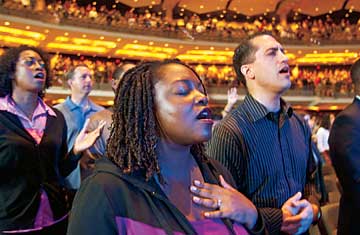
At Willow Creek, people of different ethnicities worship together
One Sunday last fall, Bill Hybels, founder and senior pastor at the Willow Creek Community Church in Chicago's northwest suburbs, was preaching on the logic and power of Jesus' words "Love thine enemy." As is his custom, Hybels was working a small semicircle of easels arrayed behind his lectern, reinforcing key phrases. Hybels' preaching is economical, precise of tone and gesture. Again by custom, he was dressed in black, which accentuated his pale complexion, blue eyes and hair, once Dutch-boy blond but now white. Indeed, if there is a whiter preacher currently running a megachurch, that man must glow.
Yet neither Hybels' sermon, nor his 23,400-person congregation, is as white as he is. Along with Jesus, he invoked Martin Luther King Jr. Then he introduced Shawn Christopher, a former backup singer for Chaka Khan, who offered a powerhouse rendition of "We Shall Overcome." As the music swelled, Larry and Renetta Butler, an African-American couple in their usual section in the 7,800-seat sanctuary, exchanged glances. Since Hybels decided 10 years ago to aggressively welcome minorities to his lily-white congregation, Renetta says, few sermons pass without a cue that he is still at it. "He always throws in something," she says. She's been around long enough to recall when this wasn't the case.
In 1963, Martin Luther King Jr. famously declared that "11 o'clock Sunday morning is the most segregated hour of the week ... And the Sunday school is still the most segregated school." That largely remains true today. Despite the growing desegregation of most key American institutions, churches are still a glaring exception. Surveys from 2007 show that fewer than 8% of American congregations have a significant racial mix.
Since Reconstruction, when African Americans fled or were ejected from white churches, black and white Christianity have developed striking differences of style and substance. The argument can be made that people attend the church they are used to; many minorities have scant desire to attend a white church, seeing their faith as an important vessel of cultural identity. But those many who desire a transracial faith life have found themselves discouraged — subtly, often unintentionally, but remarkably consistently. In an age of mixed-race malls, mixed-race pop-music charts and, yes, a mixed-race President, the church divide seems increasingly peculiar. It is troubling, even scandalous, that our most intimate public gatherings — and those most safely beyond the law's reach — remain color-coded.
But in some churches, the racial divide is beginning to erode, and it is fading fastest in one of American religion's most conservative precincts: Evangelical Christianity. According to Michael Emerson, a specialist on race and faith at Rice University, the proportion of American churches with 20% or more minority participation has languished at about 7.5% for the past nine years. But among Evangelical churches with attendance of 1,000 people or more, the slice has more than quadrupled, from 6% in 1998 to 25% in 2007.
